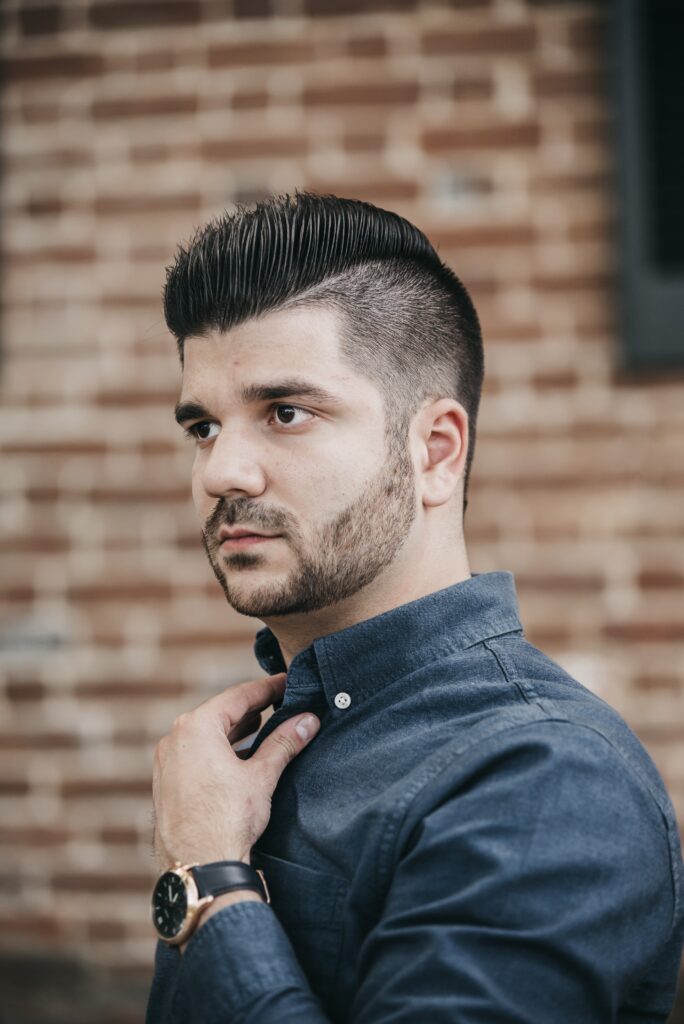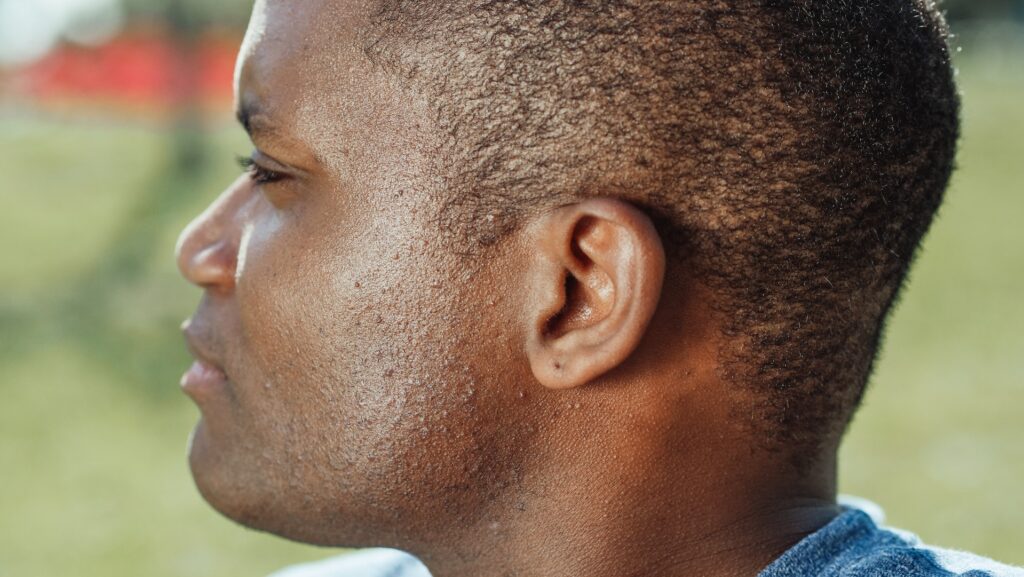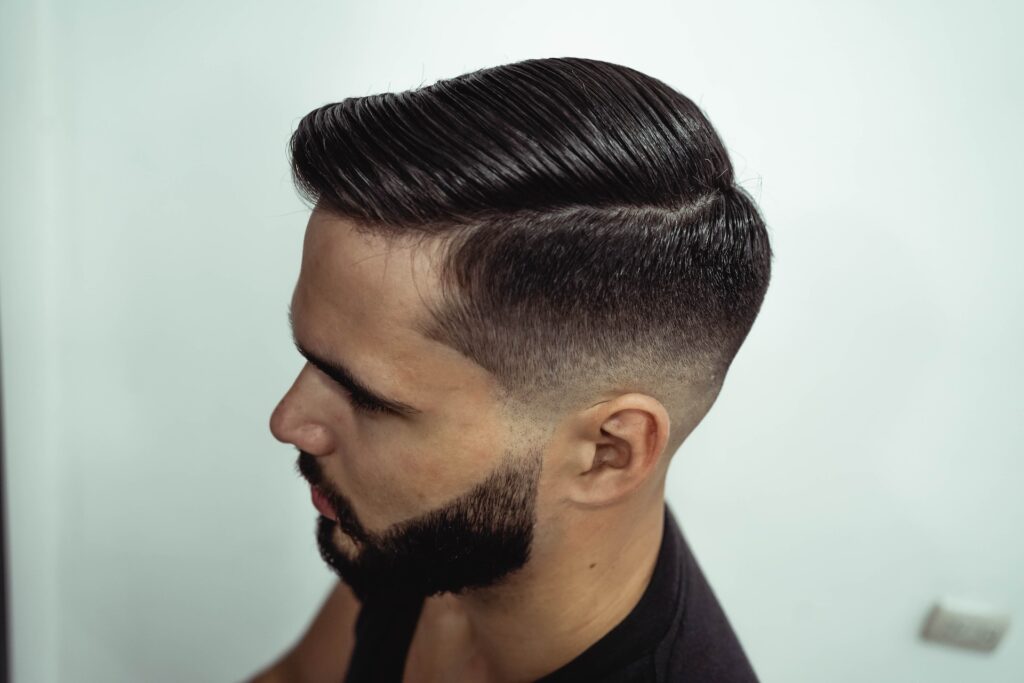Fades have quickly become one of the most popular hairstyles for men, offering a sleek and stylish appearance while maintaining versatility and adaptability.
As a classic haircut that transcends trends and time, the fade provides an effortless transition from longer hair on top to shorter or even skin-length hair on the sides and back. With a myriad of variations available, there is a fade style for everyone, making it easy for us to find the perfect look for our personal preferences and unique hair type.

We’ll be discussing the different types of fades, ranging from the classic low, medium, and high fades to the more intricate and distinctive styles like drop, skin, temple, and burst fades. By understanding the unique characteristics and visual appeal of each fade style, we can make an informed decision about the best choice for our individual needs and requirements. So, let’s dive into the exciting world of fade haircuts and discover the amazing variety it has to offer.
Understanding Fades
Decoding the Fade Haircut
Fades have become one of the most popular haircuts for men. They offer a versatile and stylish look that can be easily customized. The main characteristic of a fade haircut is the gradual transition from short hair on the sides and back to longer hair on the top. This haircut can vary significantly, allowing for both traditional and modern styles. In this section, we will explore the different types of fades to help you better understand this style.
High fades are known for being bold and attention-grabbing, as they feature shaved sides up to the top of the head. The hair is usually left longer, around an inch or two, on the top part of the skull. This style is reminiscent of the classic high and tight military style but with a modern twist.
Medium fades, on the other hand, are a more subtle option that begins at a slightly lower point than high fades. The transition is smoother and more gradual, creating a balanced and versatile look that works well for various face shapes and hair types2.
Low fades are perfect for those who prefer a more conservative look. They start just above the ear and blend seamlessly into the longer hair on top. The result is a clean and polished appearance that works for both professional and casual settings3.
Skin fades, also known as bald fades, involve shaving down to the skin on the sides and back of the head, creating a high contrast look with the longer hair on top. Skin fades can be combined with other styles, such as high, medium, or low fades4.
Temple fades focus on the area around the temple, giving a sharp and defined edge to the haircut. This type of fade is suitable for those looking for a minimal yet stylish touch.
Burst fades are a unique take on the fade haircut and often feature a circular pattern around the ears. This style frames the face and can be especially flattering for those with distinct facial features.
To choose the right fade for your look, consider your face shape, hairstyling preferences, and personal style. No matter which type of fade you choose, you can be confident that your haircut will look fresh and on-trend.
Types of Fades
High Fade
The high fade is a type of fade that starts at the highest point on the sides and back of the head, near the top of the crown, and gradually tapers down the hair length. This style can be combined with various lengths and textures on top, giving a modern and edgy look. High fades are a popular choice among those who seek a sharp contrast between the longer hair on top and shaved sides.

Photo by Kindel Media: https://www.pexels.com/photo/man-s-side-profile-in-close-up-photography-7298468/
Low Fade
The low fade focuses primarily on the lower part of the head, with the fade starting just above the ears and gradually blending up to the hair on top. This creates a more subtle transition and is suitable for people who prefer a classic and cleaner look.

Photo by iam luisao: https://www.pexels.com/photo/chico-en-barberia-12706272/
Mid Fade
A mid fade haircut balances between the high and low fades, with the taper starting around the middle part of the head. This versatile style is a popular choice, meeting the preferences of those seeking a more moderate contrast in their hairstyle.

Taper Fade
The taper fade gradually reduces the hair length from the top towards the sides and back, creating a smooth transition. This style can be customized with different levels of tapering, becoming a high, low, or mid fade. The taper fade adds a touch of sophistication to the overall hairstyle, making it perfect for any occasion.

Werner100359, CC BY-SA 4.0, via Wikimedia Commons
Skin Fade
A skin fade is a bold variation of the fade haircut where the hair is shaved down to the skin level at the sides and back of the head. This creates a pronounced contrast between the longer hair on top and the skin-tight sides. It can be combined with a high, mid, or low fade, depending on personal preference.

Temple Fade
Also known as the “shape-up” or “line-up,” the temple fade involves tapering the hair at the temples and edges of the hairline, creating a sharp and clean outline. This style is suitable for those wanting an effortlessly defined look with a touch of modern refinement.

Kct02, CC BY-SA 4.0 https://creativecommons.org/licenses/by-sa/4.0, via Wikimedia Commons
Drop Fade
The drop fade is characterized by a curved shape, gradually dipping down behind the ear before tapering back up. This unique and stylish fade complements various hairstyles and provides a smooth transition between the top and sides of the head.

Undercut Fade
Combining a fade with an undercut, this modern hairstyle features a sharp disconnect between the longer hair on top and the tapered sides. The undercut fade can range from subtle to pronounced, depending on the level of contrast you want to achieve.

Yann Caradec from Paris, France, CC BY-SA 2.0, via Wikimedia Commons
Burst Fade
The burst fade is a stylish variation that focuses on the area around the ear, with the rest of the hair remaining longer. This creates a burst-like effect, hence its name. It’s often paired with a mohawk or a pompadour hairstyle, giving a trendy and distinctive look.
Bald Fade
Also known as the “skin fade” or “razor fade,” the bald fade is characterized by the hair being shaved down to the skin level on the sides and back of the head. This creates the most pronounced contrast in fading hairstyles, making it an excellent choice for those wanting a bold and edgy look.
Factors to Consider
When deciding on the perfect fade haircut, there are several factors to take into consideration. Some of the most important aspects to keep in mind are hair textures and hair length. We will discuss each of these factors below.
Hair Textures
Different hair textures can significantly impact the outcome of your fade haircut. Here, we’ll go over some common hair textures and how they can affect the fade.
- Curly hair: Fades work great with curly hair, providing a clean contrast between the longer, curly top and the short sides. This can showcase your curls while keeping your hair tidy and manageable. Remember to consult with your barber or hairstylist to determine the best fade type for your curl pattern.
- Straight hair: Straight hair also works well with fades, as it can easily be blended into various fade styles. A skilled barber can create a smooth transition between different lengths, resulting in a sleek and sharp look.
- Wavy hair: Wavy hair provides a unique texture that can be utilized to create interesting fades. With the right hairstylist, you can achieve a dynamic appearance that accentuates your natural waves.
- Thick hair: For those with thick hair, fades can be especially helpful in making your hair more manageable and reducing bulk. Additionally, thick hair may require extra attention during the haircut to ensure that the fade is even and well-blended.
Hair Length
Another important factor to consider when choosing a fade style is your current hair length and desired look. Some fade styles may be more suitable for certain lengths.
- Buzzed: If you prefer shorter hair, a buzz fade is a great option. This style seamlessly transitions from a buzz cut on top to a fade on the sides, resulting in a low-maintenance look.
- Short to medium length: For those with short to medium length hair, a variety of fade styles can work well. High, low, or skin fades are all viable options, depending on your preference and face shape.
- Longer hair: If you have longer hair, you may want to consider a fade that starts higher on the head and gently tapers down to a shorter length on the sides. This can help preserve your length while still experiencing the benefits of a fade haircut.
We hope this information assists you in choosing the best fade style for your hair texture and length. Discussing your preferences with your barber or hairstylist will ultimately lead to the perfect fade for you.
Maintaining Your Fade
Maintaining a fade haircut is essential to keep it looking fresh and well-groomed. In this section, we will discuss some tips and products that can help you maintain your fade with ease.
First, it’s crucial to visit the barbershop regularly to keep the fade clean and sharp. Depending on how fast your hair grows, you may need a touch-up every two to four weeks. However, if you want to maintain your fade at home, investing in a high-quality set of hair clippers with multiple blade lengths is essential. With the right tools and a good mirror setup, you can keep your fade in perfect shape without having to visit the barbershop every week.
When it comes to styling your fade, choosing the right product is crucial. There are various styling products available, such as gel, pomade, and wax. Each product offers different benefits, but the choice ultimately comes down to personal preference and the desired look.
- Gel: Ideal for a wet look with strong hold, gel is perfect for hairstyles that require structure and definition. It dries quickly and is easy to apply and remove.
- Pomade: Pomades provide a medium to strong hold and a glossy finish. They work well for slicked-back styles and are easy to re-style throughout the day.
- Wax: Suitable for a natural look with a medium hold, wax offers a matte finish and is perfect for more textured and messy styles.
To use these products effectively, take a small amount and rub it between your palms to warm it up. Then, work the product through your hair, focusing on the areas where you want more definition and hold. Use your fingers, a comb, or a brush to shape your hairstyle as desired.
In addition to styling products, paying attention to the clipper guard size when trimming your hair is essential to maintaining a consistent and neat fade. Generally, shorter clipper guards are used for the lower part of the fade, while longer guards are used as you move up the head.
By following these tips and using the right products, you can easily maintain your fade haircut, ensuring you look stylish and well-groomed at all times.
Fade Styles
Pompadour Fade
The Pompadour Fade is a timeless and classy style that combines the classic pompadour with a modern fade. This style showcases longer hair on top, brushed back and held in place with a styling product, while the sides and back are tapered for a smooth, clean look. The pompadour fade offers versatility as you can opt for high, medium, or low fades, depending on your preference.
Mohawk Fade
Incorporating elements from the classic mohawk and a fade, the Mohawk Fade is a bold and distinctive haircut. The hair on top is left longer and can be spiked or styled upwards, while the sides and back are faded from a bald or skin fade. This daring style can be customized with hair designs, offering a unique and eye-catching look.
Quiff Fade
The Quiff Fade is a stylish and versatile haircut that combines the popular quiff with a fade. In this style, the top hair is brushed upwards and backwards, creating a voluminous quiff. The sides and back are then faded, creating an appealing contrast. You can experiment with different types of fades, such as high, mid, or low, to find the perfect quiff fade for your individual taste.
Comb Over Fade
A Comb Over Fade is a sleek and professional haircut, featuring a side part and a taper on the sides and back. The hair on top is combed to one side, sometimes with a hard part for added definition. The fade can be tailored to your preference, opting for a skin, bald, or lower fade depending on your desired look. This versatile style works well for both professional and casual settings.
Buzz Cut Fade
For a low-maintenance yet fashionable haircut, the Buzz Cut Fade is a popular choice. The hair all over the head is cut very short using clippers, then the sides and back are faded to create a smoother transition. With a variety of fade options, such as a skin or bald fade, the buzz cut fade offers an edgy, no-fuss style suitable for any occasion.
Faux Hawk Fade
A trendy and playful look, the Faux Hawk Fade is a fantastic option for those seeking a mohawk-inspired style with a less dramatic effect. The top hair is trimmed shorter than a mohawk but still maintains some length, which can be textured and styled upwards. The sides and back are faded, creating a seamless transition and adding a modern touch to this striking haircut.
Fades for Different Lifestyles
Business Professional
When it comes to hairstyles that suit the business professional lifestyle, a fade haircut can still be a great option. We recommend opting for a low fade or a medium fade, as these styles provide a more subtle transition from the longer hair on top to the shorter sides. This can give a polished and clean appearance without being overly trendy or extreme. For added sophistication, pair your fade with a well-groomed beard or even just some light stubble, depending on your workplace’s dress code standards.
To maintain this professional look, it’s important to visit your barber regularly to keep your fade looking fresh and sharp. Schedule appointments every 3-4 weeks to ensure that your haircut remains neat and presentable.
Low-Maintenance Style
For those who lead a busy life and prefer a low-maintenance haircut, a fade can also be an excellent choice. One of the most popular fades for a low-maintenance style is the skin fade, where the hair is so short on the sides that it tapers down to the skin, giving you a clean-cut appearance without much daily upkeep. Skin fades can be started anywhere on the head, but the general rule remains the same: the hair eventually gets short enough so that you can see the skin beneath 1.
Another option for a low-maintenance fade is the drop fade, which features a subtle drop in the fade’s height as it moves towards the back of the head, following the natural curvature of the skull. This type of fade tends to work well with various hair types and face shapes, making it a versatile style that can be easily maintained with regular trims.
With these low-maintenance fades, you can easily style your hair using minimal products, such as lightweight pomades or matte clays, to keep your hair looking its best without much effort. This helps make your morning routine quick and straightforward while still looking fashionable and well-groomed throughout the day.
Footnotes
Frequently Asked Questions
We often receive questions about the various types of fades and their differences. To provide a clearer understanding, we’ve compiled some common inquiries and answered them in this section.
One crucial question is, what is the difference between a taper and a fade? A taper and a fade are similar haircuts, but they have key differences. A fade is characterized by a blended transition from short and sparse to longer and dense hair lengths at the side and back of the head. The hair is cut to mimic a gradient that “fades” before it reaches the natural hairline. A taper, on the other hand, involves a gradual shortening of the hair towards the neck or temples, without necessarily reaching the skin like a fade does.
Now, let’s discuss the popular types of fades available to choose from. There are at least seven main types of fades, including high fades, medium fades, low fades, drop fades, skin fades, temple fades, and burst fades. Each of these styles serves a unique purpose, offering a distinct look and style to suit different preferences.
When selecting the right fade style, consider factors such as your face shape, hair type, and desired outcome. If you’re unsure, a skilled barber can help guide you in choosing the perfect fade for your look.
Another question people often ask is, how often should a fade haircut be maintained? The maintenance of a fade haircut largely depends on the specific type of fade and the speed at which your hair grows. Generally, to keep your fade looking fresh and polished, it’s recommended to see your barber every 2-4 weeks for a trim.
Lastly, it’s important to remember that fades can be diverse, and they can be catered to fit different hair types and textures, including curly, wavy, or straight hair.
We hope these responses help clarify some common questions regarding fade haircuts and assist you in making an informed decision when choosing your next hairstyle.




